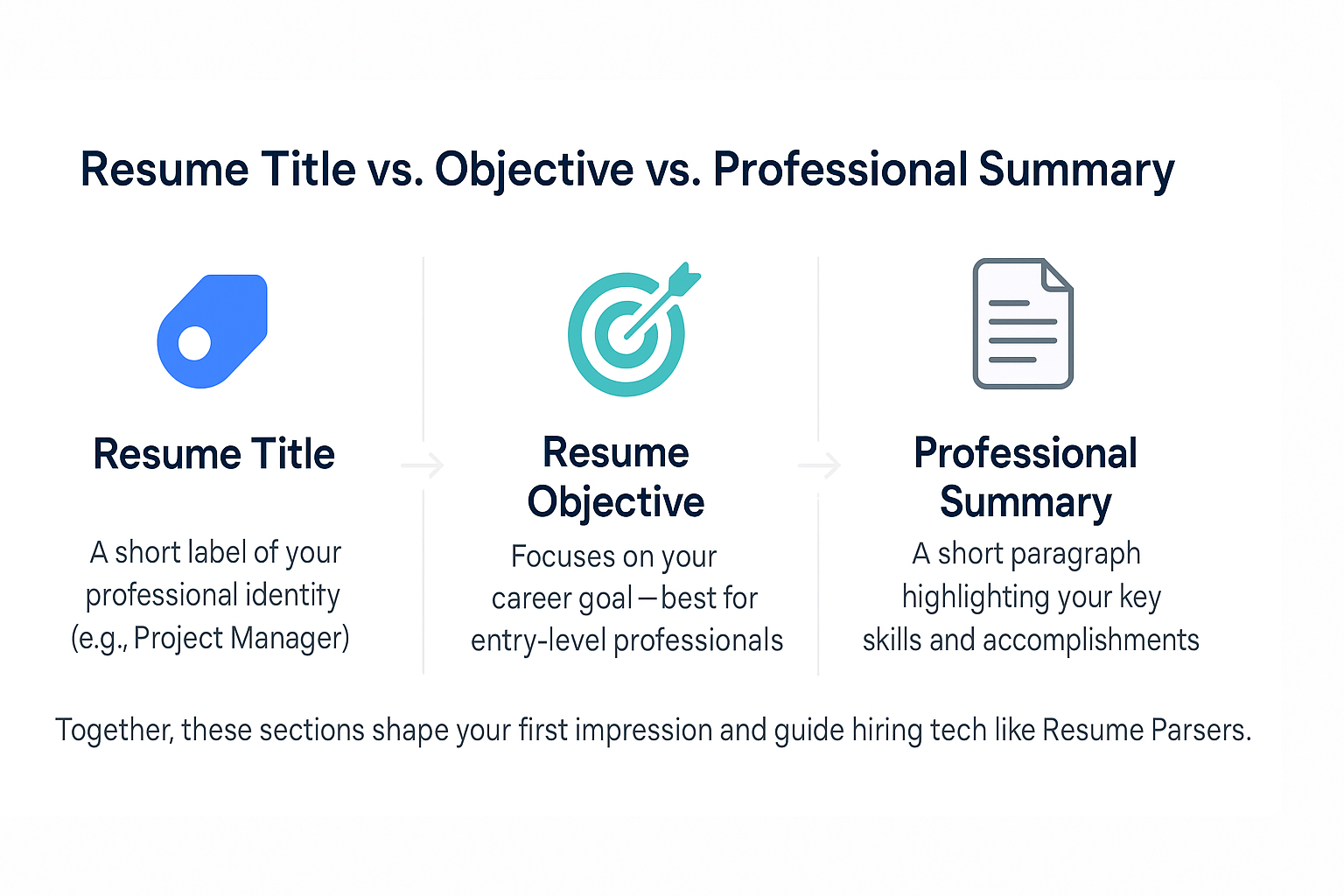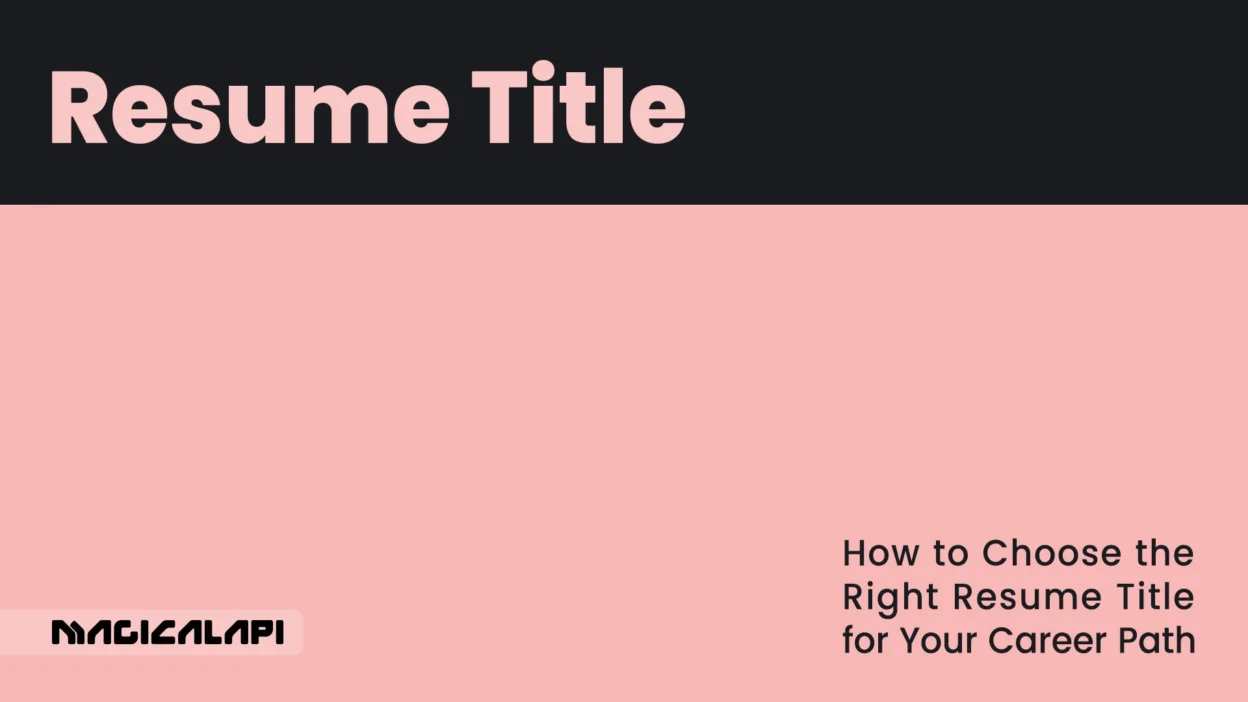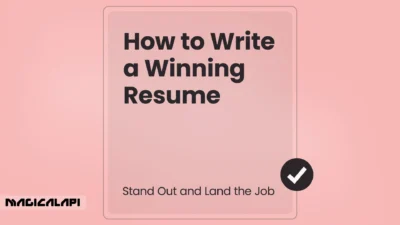When you are in job search mode, the pressure is on. If a recruiter spends more than a brief fraction of time scanning your application, you are fortunate. You know that the time it takes to reach your wealth of experience or skills, before seeing one small, but significant word, the resume title.
The title is not simply a formality; the title you choose is critical. It cues human and machine readers to your candidacy. It can act as a headline for your candidacy, provide a quick professional snapshot, and serve as a directional sign for the reader.
The title, if done right, communicates your value proposition and career direction all in one word. It gives you a critical first impression to entice the reader to continue. If your title is vague or poorly chosen, you run the risk of your entire application being discarded—even when the experience is high quality.
This thorough guide will take you through both the art and science of choosing the best resume title that is both human-readable and optimized for Applicant Tracking Systems (ATS). We will discuss its meaning, the significant role it plays in the hiring process, as well as takeaway tips and examples you can use throughout your career journey.
Table of Contents
What Is a Resume Title and Why Does It Matter?
Before we get into the “how,” we first need to answer the big question: What is a resume title? A resume title, or headline, or perhaps a branding statement, is a short phrase (usually one to seven words) placed immediately after your contact information at or near the top of your resume.
It is a summation, your professional title condensed into one impactful line. Unlike an objective statement, which outlines what you’re hoping to get out of the job you are applying for, resume titles focus instead on who you are as a professional and the value you bring. How to Choose the Right Resume Title?
The Value of Immediate Clarity
Right now, clarity is king in the job market. Recruiters are moving through large amounts of candidates. They can’t necessarily sift through paragraphs of text to determine what function you perform. The title on your resume gives them that immediate clarity.
Your title should immediately relay to the reader what function you hold and to what level of expertise. “Senior Digital Marketing Manager” or “Certified Public Accountant with 10+ Years of Experience” give clarity quickly without needing anything else to establish credibility. This is more effective than nothing at all or using a generic descriptor.
Developing the Tone of Your Story
The title on your resume is the first sentence that will be seen and therefore the first point from which the reader will develop the rest of your career story. It gives context for the rest of your information. If the recruiter sees “Senior Software Engineer,” they will likely expect complexity in project work, some evidence of leadership past projects, and experience in specific programming languages when reading the rest of your document.
If the reader sees “Creative Professional,” though, they will be guessing and will have to take some time to piece together the story they hope to read, which they do not typically have. This clarity is critical in allowing a potential employer to quickly assess qualitatively, and often quantitatively, your fit as a candidate. Read more about how to write a winning resume?
The Role of Resume Titles in ATS and Recruiter Screening
Today’s hiring process can be seen as two phases: the machine comes first and then the person. Your resume title is perhaps one of the most important components to getting past the machine: the Applicant Tracking System (ATS).
Magical Resume Score
Discover everything you need to know about Magical Resume Score , how it evaluates your resume, and the various options available to enhance your job application and improve your chances of success.
Optimized for the ATS win
Most large and mid-sized companies rely on an ATS to sort and filter candidates. These systems are built to parse, store, and rank resumes based on keywords and relevance to the job description.
When the ATS analyzes your documents, your resume title is one of the first and most critical sources of contextual keywords. For instance, if the job posting is for someone to be “Senior Data Analyst,” and your title is “Data Analyst,” ATS will definitely see those two titles are in the same category; thus, it will rank you higher than someone whose title may be “Detail-Oriented Problem Solver.”
In the latter case, the ATS would have trouble categorizing your profile and ultimately give you a lower Resume Score if they can’t assign correct context before ranking you. The more keywords or contextual keywords you have, the better your opportunity to land the job.
A well-written, keyword-enhanced title serves as a header tag to the ATS, confirming your area of expertise. This is a basic step in preparing your application for passing the first automatic gate. Programs such as a complete Resume checker can help you find out if your header and other key parts are written with the ATS in mind.
Recruiter Perception and Time Management
After the ATS processes the resume, it is in the hands of a recruiter. Recruiters review resumes in an F-pattern, scanning the upper third of the page in short order. This is where your title lives.
From the recruiter’s viewpoint, your title gives them four pieces of immediate information:
- Relevance: Is this candidate relevant to the core job function I am trying to fill?
- Level: Is this person an entry-level, mid-career, or senior-level candidate?
- Specialization: Does this candidate have the precise niche experience we need (i.e. “DevOps Specialist” vs. “Software Engineer”)?
- Enthusiasm: Is the person confident and oriented with the way they describe themselves?
A strong, precise title lowers the cognitive load to the recruiter and allows them to quickly place you into a bucket; they can quickly determine if they care to give you the next 30 seconds to read the bullet points. It’s a return on the recruiter’s investment in their time, which pays off in engagement.
The Critical Difference: Resume Title vs. Resume Objective vs. Professional Summary
Many candidates mistake the title as a precursor to one of the other sections of the resume. Being clear about this distinction as you begin formatting and messaging.

- Resume Objective: This focuses on yourself and what you want (e.g., “Seeking a challenging position where I can utilize the customer service skills I have practiced over a ten-year, two-continent career…”). This is mostly for when you are beginning a career or are an inexperienced professional.
- Professional Summary (or Resume Summary): This is a 3-5 line paragraph/ bullet section that summarizes your career high points, your key skills, and your greatest accomplishments, which serve as a narrative of the value you offer.
- Resume Title: This is a single word, concise label of your current or desired professional identity.
The title is a short label, and the summary is the paragraph that bolsters the label. When all three (title, summary, objective) sections are properly formatted and structured, they should create one holistic professional introduction.
For example, a candidate may use the title, “Cross-Functional Project Manager” and then they would write a professional summary that explains that they are a Project Management Professional (PMP), that they have been successful in managing budgets of $5M, and they are effective communicators who communicate collaboratively. If you use a tool like a Resume Parser, you also will clearly see how hiring technology is interpreting these sections in the modern recruiting landscape.
How to Match Your Resume Title to Your Desired Career Path
The key to a standout resume title is alignment. A winning title harmonizes your past experience to your future goals and the job description you are targeting. To achieve this, research and self-assessment is a must.
1. Research Job Titles of Interest
Don’t guess. When you begin your search, look at job boards and the company career page. Specifically, what titles are assigned to the positions you want? For example, if you want to apply for a “Content Strategist” position, don’t put down “Writer,” which is better defined, but rather, use the title “Content Strategist” the employer has used for the job. Your title should also include the most commonly used title, so keyword loaded, for future search optimization.
2. Determine Your Niche and Level.
You need to assess and take a longer look at your level – are you an entry-level “Analyst” or “Senior Financial Analyst”? Frequently, you will want to use a modifier:
- Entry-Level: Junior, Associate, Entry-Level, or Aspiring
- Mid-Career: Specialist, Expert, Professional, Seasoned, Experienced
- Senior: Senior, Lead, Principal, Director, Executive, or VP
3. Utilize Important Specialties/Certifications.
If your industry is dependent on the use of tools or certifications then you definitely want to use that to your favor to differentiate yourself and generate a keyword rich title.
- Don’t Use: “HR Manager.”
- Use: “SHRM-Certified Talent Acquisition Manager.”
- Don’t Use: “Sales Rep.”
- Use: “B2B SaaS Account Executive.”
If you are nervous about how to format this, take a few minutes looking at resume title examples in your industry. You will get great insight into the common terminology used to describe a professional. Also, new technologies can also inform what title should be used with knowledge of How to use ai to write a resume to generate data-based titles which will optimize for common industry keywords.
Resume Title Examples for Entry-Level Professionals
For those just starting out, your title must clearly articulate your desired function and convey enthusiasm and potential, making up for limited professional experience.
| Career Path | Generic/Weak Title | Strong/Targeted Resume Title |
| Marketing | Recent Graduate | Aspiring Digital Marketing Coordinator |
| Tech/Coding | Developer | Entry-Level Full-Stack Developer (Python/React) |
| Finance | Business Student | Junior Financial Analyst Candidate |
| Administration | Assistant | Results-Oriented Administrative Associate |
| General | Seeking Position | Entry-Level [Industry] Professional |
The key here is specificity. Naming your desired role ensures the ATS and recruiter instantly place you in the correct hiring pipeline.
Resume Title Ideas for Mid-Career and Experienced Candidates
Mid-career and senior professionals must use their title to highlight depth of experience, specialization, and leadership capabilities. The title should suggest achievement, not just activity.
| Career Path | Generic/Weak Title | Strong/Targeted Resume Title |
| Sales | Sales Manager | Strategic B2B Sales Director (15+ Years) |
| Operations | Manager | PMP-Certified Operations & Logistics Leader |
| Product | Product Manager | Senior Product Manager, SAAS (Go-to-Market Expert) |
| HR | HR Generalist | Talent Acquisition Specialist & HRIS Architect |
| Creative | Designer | Principal UX/UI Designer (Figma & Accessibility Focus) |
If you are very experienced, especially if you have been working for a decade or longer, a direct indication of your experience amount can be effectively communicated by putting the number directly in the title (e.g. “15+ Years” directly in your title can help the reader understand your level of experience).
Finally, given the technological advancements in hiring platforms, you should consider that AI Resume Optimization: Revolution or Risk? may determine if your advanced titles are accurately interpreted by some human readable software.
Magical Resume Checker
Discover the full potential of the Magical Resume Checker and explore the various options available to enhance your resume, optimize it for applicant tracking systems (ATS), and improve your chances of landing your dream job.
Strategies for Career Changers: Crafting a Transitional Resume Title
For job seekers, one of the hardest challenges is to move into another career. The title you’ve had is no longer relevant, and the new title won’t mean anything to the prospective employer. The transition title makes this very clear by demonstrating transferrable skills and the future goal.
1. The “Current Skill to Future Role” Method
This method lends itself to a hyphen or slash—a combination of your most transferrable skill with your future position. The transition title reassures a recruiter that even though you are transitioning, you are bringing an asset to the position.
- From Teacher to Corporate Trainer: Instructional Design Professional & Corporate Trainer
- From Journalist to Content Marketer: SEO-Driven Content Strategist
- From Military to Project Management: Transitioning Military Leader, PMP Candidate
2. Highlighting Transferable Expertise
At times, the most impactful title illustrates your primary, transferable skill, plus what you would like to utilize that skill for. This is especially effective if you are change paradigms in function. Case in point, if you were an exceptional operations manager in retail, and are now hoping to become one in tech, your title can be “Operations Excellence Leader, Targeting Tech.”
When creating a transition title, keep in mind that you are marketing to the other party and selling your potential and every word should be thoughtfully chosen to influence the recruiter’s perspective.
Tailoring Your Resume Title for Specific Job Applications
The rule of thumb for writing a resume is to never take the “one size fits all” approach. This rule applies the strongest to your resume title.
You must tailor your title for each job opportunity. The essence of your profession is the same, but the specific job description will always give you great keywords that you can incorporate.
The Twinning Strategy:
- Identify the Target Title: Find the target title in the company’s posting. For example – Digital Marketing Specialist II.
- Add Your Modifier: Add a specific modifier to clarify what your unique selling point is. For example, “Certified Google Ads Expert”.
- Finalize Your Title: Compiled it all together to be the complete title tailored for the specific position: Digital Marketing Specialist II: Certified Google Ads Expert.
This strategy works so well is that it is instant feedback to the ATS and the recruiter that your resume is an extreme match for the position they posted. This is how an average job seeker elevates their application to the level of being submitted as a one of the top candidates.
Common Mistakes to Avoid When Writing a Resume Title
A strong title carries a lot of weight and a bad title could do damage. Be sure to avoid these pitfalls:
1. Ambiguous or Vague Words
Steer clear of words that are descriptive of personal character traits and have no reference to your job function, including: “Hard Worker,” “Detail-Oriented,” or “Motivated Individual.” These are good descriptors for your summary section, but are not good descriptors for your title because there are no keywords for the ATS and does not offer any professional relevancy for the recruiter.
2. Excessive Fluff/Jargon
It is good to use keyword-heavy descriptors, but not buzz-word jargon with no substance. Do not write overly flower phrases, such as: “Synergistic, results-driven paradigm architect.” Stick to clear, recognizable professional wording that everyone in that industry would understand.
3. Using Your Name or Contact Information
Your name and contact information belong at the very top of the page. The title space is meant for professional descriptors only. Don’t ever write the title “John Smith.”
4. Incorrect Level of Seniority
Do not call yourself “Director” if your last title was “Associate.” Lying about your seniority just leads to awkward conversations or immediate disqualification once it is clear what your experience was. Always aim high, but you should aim high respectfully.
Testing and Optimization: Ensuring Your Resume Title is a Winner
Never just put your resume title into place and forget it. Like anything that how marketing works, you need to find what is effective through testing and optimizing.
1. The Five-Second Test
Show your resume to three professional contacts that are not in your direct field of work, and ask this question: “Based on the top of this resume, what job to think I am applying for?” If all three of them answer consistently and in five seconds or less, your title is clear enough. If they struggle, then you need more specificity.
2. Self-ATS Test
Before submitting a resume, test your title through a check in your mind: “If a machine could only read this title, would it file me under the correct job category?” If the answer is yes, then you are ATS-optimized. This is literally the easiest way to test the Resume Score.
3. A/B testing Your Applications
If you are applying to similar jobs, but are getting different response rates, try little tweaks to your title. Ex: Split your applications at the title. Half could be submitted under “Senior Financial Analyst (Forecasting Expert)” and other half “Financial Planning & Analysis Lead.” Keeping track of each title’s success is the ultimate optimization. A killer title that you can optimize through testing, is your hidden weapon.
Final Tips for Choosing the Perfect Resume Title
- Be Specific: A specific title will always be stronger than a general one. “Supply Chain Logistics Specialist” is better than “Manager.”
- Prioritize the Keyword: Just make sure the key function you are targeting is the first or second word.
- Keep it Short: No more than 7 or 8 words to maintain attention.
- Use Proper Case: Write the title as if it is a heading for a newspaper article, so major words should be capitalized.
By thinking of your resume title as the professional headline it is, you make sure that your application will not only keep the eye of the recruiter but also successfully navigate the technical layout to be sifted through the complexities of hiring systems today.
Conclusion: Choosing a Resume Title
Choosing your resume title is a minor task that will reap enormous rewards. It is the essential piece of metadata that tells a human or a machine who you are, what you can do, and where you fit in their organization.
Applying the principles of clarity, specificity, and optimization elaborated in this guide (matching your expertise to the words used in the job market) will turn your resume from a job document into a truly effective tool for marketing your career. Take the time, be deliberate, and select the title that will open the door to your next opportunity.
FAQs about what is a resume title
1. If I am pursuing a promotion, should I still share my current job title?
No, you should use the title of the role you would like to have next. Your title should be a step up but realistic. If you are “Associate” is applying for a Senior role, you might describe yourself as “Senior Associate Analyst” or “Experience Financial Analyst.” Your want to sell your future potential not your past experiences.
2. Where should the title live in the resume?
The title should live immediately below your full name and contact information, it should begin at the very top of the resume. Generally it should be smaller than your name, but larger than the body text. Use bold or slightly different fonts to help the title stand out immediately.
3. Can I use two distinct job functions in the same title?
Yes, if those two functions are closely related and exhibit legitimate cross-functional experience. For instance, “UX Designer & Front-End Developer” works well, as there is an overlap in skills. You should avoid using job functions that do not relate, such as “Accountant & Social Media Manager.”
4. If I have a certification (such as PMP or CPA), should it go in the title of my resume?
Absolutely. You will want to include major, relevant certifications. Including a major certification, like that of your PMP, greatly enhances your authority and searchability. It is best to include the certification in the title of your resume, such as “PMP-Certified Project Manager.” This way, both the recruiter – and the ATS – can recognize your certification instantly.





